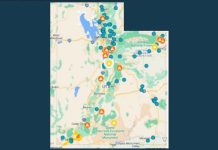UTAH LAKE, Utah, June 25, 2018 (Gephardt Daily) — Officials are warning the public Monday that the potentially harmful algal bloom affecting Utah Lake’s Provo Bay has spread to more areas.
A news release from Utah Department of Environmental Quality said that people and their pets are being warned to stay out of Provo Bay, Lincoln Marina, Sandy Beach and the Utah Lake State Park.
The Utah DEQ Division of Water Quality has collected samples and found the presence of cyanobacterial toxins exceed the recommended recreational levels for microcystin, the news release said.
“It is important for the public to be aware of the additional warnings on Utah Lake,” said Eric Edwards, Deputy Director of Utah County Health Department. “Utah Lake is a huge lake with some areas not currently affected. We would remind those recreating to be mindful of certain areas of the lake that have samples exceeding the recreational levels for toxins.”
Water Quality crews took additional water samples on June 20 at eight Utah Lake sites. Three sites sampled — Lincoln Marina, Sandy Beach and Utah Lake State Park — exceed recreational toxin thresholds.
Sample results detected the presence of microcystin, with samples at the three sites exceeding the Utah Department of Health/Utah Department of Environmental Quality health-based threshold for recreational waters.
Water Quality crews will continue to collect additional samples around the lake beginning Monday. UCHD has posted warning signs at Lincoln Marina, Sandy Beach and Utah Lake State Park to warn people about recreating in the Bay due to the presence of potentially harmful algal blooms.
“Although cyanobacteria are a natural part of many freshwater ecosystems, under the right
conditions they can proliferate rapidly,” the news release said.
“High levels of nutrients in the water, combined with warm temperatures, abundant sunlight and calm water, can promote growth, resulting in extensive blooms. These blooms consist of cyanobacteria, often referred to as blue-green algae or harmful algal blooms, a type of bacteria that poses risks to humans, wildlife, domestic animals and fish.”
Symptoms of exposure include headache, fever, diarrhea, abdominal pain, nausea and vomiting, and sometimes allergic reactions from skin contact.
For concerns about possible human exposure, call the Utah Poison Control Center at 800-
222-1222, or your physician. Utah DEQ will continue to provide updated information here.







